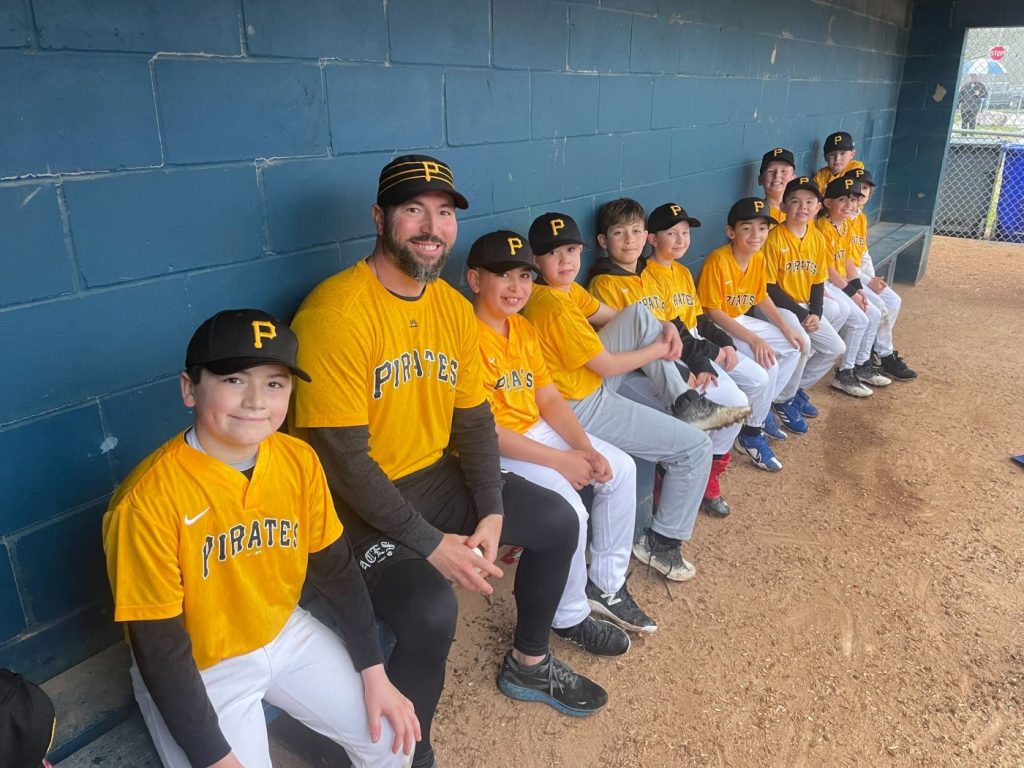He was in the same 2004 draft class as Justin Verlander, Dallas Braden, Dustin Pedroia and Hunter Pence. He’s 42 and hasn’t pitched on a professional diamond in a decade. He has had two Tommy John surgeries and coaches his two sons in Little League.
Yet when pitchers and catchers reported to Florida and Arizona for spring training this week, Rob Semerano felt overlooked. Left behind. Maybe a bit aggrieved. But the former Athletics prospect still hasn’t given up.
It’s not a blind belief, either; there’s tangible evidence Semerano has major league talent even at his age. Through determination, physical gifts and a willingness to embrace a physics professor’s unorthodox strategies, Semerano routinely hits 101 mph on the radar gun — faster than he ever did in the minor leagues. He threw in front of Rangers officials this week and has another tryout with the Yankees lined up.
With spring training underway, there aren’t many guys with 100-mph fastballs just sitting back home on their couch. Until he gets a chance, Semerano and those close to him have been left to wonder: What’s preventing the A’s or any other team from extending a camp invitation?
“I have not heard from them, but I’d love to play for the A’s again,” Semerano said. “I really love that organization, that’s the first organization that signed me, so obviously they have a special place in my heart. But no, I have not heard from them yet. And frankly, I’d love to play for any major league team.”
Semerano’s former teammates in the A’s organization have no trouble recollecting what he was like, even 20 years removed from the low minor league levels. He had a cerebral approach, work ethic and a quirky sense of humor.
From the bullpen, he’d joke with young fans in the stands during games. He’d do impersonations of Babe Ruth and other ballplayers. And, despite undergoing Tommy John surgery at Fordham University, he could throw hard.
“He always had good ride on his fastball,” said MLB Network analyst Anthony Recker, who played with Semerano in 2006 and 2007. ”Even back then, he was pumping 95, 96.”
Semerano inched closer to the big leagues, moving from the Athletics’ farm system to the Yankees’ and then the Astros’. In 2009, he joined Houston’s major league spring camp, but suffered his second serious elbow injury that required Tommy John surgery. That was the end of his baseball career at age 28, or so at least it was supposed to be.
Forced into retirement, Semerano founded a youth baseball skill development company in his native New Jersey. His MLB dreams never died, but he put them on the back burner. His 2021 divorce changed his focus — he wanted to teach his two sons a lesson about facing adversity head-on.
Braden, the A’s broadcaster drafted by Oakland four rounds after Semerano, marvels at the 42-year-old’s drive.
“I think if you just take a few minutes to kind of realize his path and then what he’s gone through in his life, and the idea that he’s trying to set an example for his children — there’s a lot more to this than just him chasing a dream,” Braden said. “I think you really get a sense of how much it means to him to do this and show his children that you don’t ever have to give up on anything you love.”
Semerano installed a regulation-sized pitching mound in his New Jersey backyard and trained. By happenstance, he met Don Mueller, a chemical physics Ph. D. who calls himself the “nutty professor of sports.”
Mueller pitched Semerano on a new pitching delivery, one that coaches don’t teach: the neutral wrist. Forever a curious thinker, Semerano heard Mueller out.
The A’s drafted Rob Semerano in the 20th round of the 2004 Draft, four rounds ahead of future star Dallas Braden
Rather than the traditional cranking motion in which pitchers grip the ball with a stiff wrist and hurl it home, Mueller advised Semerano to hold the ball as loosely as possible, lead with his elbow and snap his wrist and forearm down. The action creates more of a catapult or whipping motion, taking pressure off the elbow. The arm moves more like a “Chuckit!” tennis ball launcher for dogs.
In six months working with Mueller, Semerano’s fastball went from 91 mph to 101 mph, the physicist said. Even knowing baseball is historically averse to going against the grain, Semerano’s progress with the neutral wrist has left Mueller screaming into the void.
“Why don’t people want to listen to this?” Mueller said.
It’s hard for Semerano to quantify how much Mueller’s advice has helped him. He’s constantly experimenting with training methods, eating habits, and workouts.
“But I do know one thing that it’s really affected is: My arm feels great every single day,” Semerano said. “And I can throw and throw and throw and throw, and my arm just feels great. If there’s anything that gets tired, it’s my legs.”
Much of pitching is physics: how to leverage your body to get the most torque, and thus velocity. The two studied former A’s and Giants star Vida Blue, looking at his lower half. Mueller used former Giants ace Tim Lincecum as an example of a windup that puts the pitcher’s body at risk.
Mueller has aggressively sought to promote Semerano’s comeback. He calls reporters and team officials to help his pupil and, perhaps, gain validation for his own unconventional teachings.
Semerano’s story has been documented in the Pittsburgh Post-Gazette, the Asbury Park Press and other outlets. When a local New York CBS station produced a video and written package last August, Semerano started getting calls. Mueller said Semerano declined an opportunity to pitch for the Savannah Bananas, the barnstorming Globetrotters-esque entertainment team.
More serious offers came, leading to the recent tryout with the Rangers and, as of Feb. 14, the forthcoming one with the New Jersey native’s Yankees. Although a lower-body injury slowed Semerano’s velocity to the mid-90s in front of the Rangers’ brass, Semerano said they came away impressed.
“If this was two years ago, I’d sign you right now,” Semerano recalled the Texas scout saying, but roster limitations complicated the decision.
Offering a non-roster spring training invitation costs next to nothing for an organization. Even a franchise like the A’s could easily afford it.
The irony of the Athletics not being among the clubs to show interest is that a talent like Semerano is exactly the type that Billy Beane, who drafted and signed the righty in 2004, would pursue. He’s an undervalued asset with a defect that causes him to be written off — his age and injury history.
“I mean, if a dude’s throwing 101, he should probably have the right eyes on him,” Recker said. “Bringing him into camp probably can’t hurt.”
Braden noted that it’s possible teams might be hesitant to give Semerano an opportunity because it could take a roster spot away from a younger player or cause a distraction. Still, Semerano isn’t looking for a multi-year deal, just a chance. There’s very little downside.
The A’s, surrounded by dark clouds of ineptitude, disloyalty and antagonizing its fan base, could use a feel-good story. What could be better than a former prospect who has drawn comparisons to the movie “The Rookie,” based on the true story of a high school baseball coach who made his miraculous MLB debut at 35?
All the A’s, or another team, have to do to set a made-for-Hollywood story in motion is to extend an invitation. They have nothing to lose.
“I mean, you see 100, if you didn’t know who it was, would you do it? Probably,” said Nationals hitting coach and former Semerano teammate Tommy Everidge. “I think he’s got the character of someone that would be worth signing. He always worked hard, and he’s a stand-up guy. Why not?”
Recker admitted that back when they played, Semerano didn’t have much of a secondary pitch to play off his fastball. There’s no way for a team to find out if that has changed in the 18 years since without seeing him pitch. Even the fastball itself is worth seeing.
And if Semerano is throwing 101 just training on his own, what could he look like with major league coaching, facilities and training?
“When I think about scouting pitchers the last couple years, whenever you hear 100, 102, immediately as a hitting coach, you’re going to hone in on that guy and try to figure out how you’re going to beat him,” Everidge said. “So I don’t see why it wouldn’t be possible. Stuff is stuff.”
A more apt – and modern – comparison for Semerano might not be Jim Morris (“The Rookie”) but Daniel Bard. The reliever fell out of big league relevance for seven years despite a promising early career due to mental and command struggles. But as a minor league coach, he learned more about the biomechanics of pitching and mounted a successful comeback in his late 30s.
As someone whose perseverance and mental strength helped him overcome long odds, Bard’s comeback story was inspirational.
Semerano’s comeback story could resonate in a different way for people who feel they are aging out of opportunities.
“Although it seems like there’s a lot of doors closing for people at a certain age, the doors are not completely closed,” he said. “And if you do enough to turn heads, you can knock those doors open again.”


